Stuart Eiffert
Experimental Evaluation of a Hierarchical Operating Framework for Ground Robots in Agriculture
May 23, 2021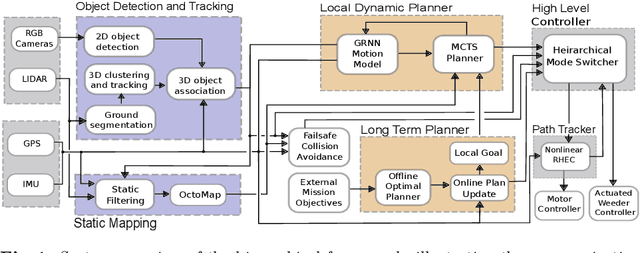
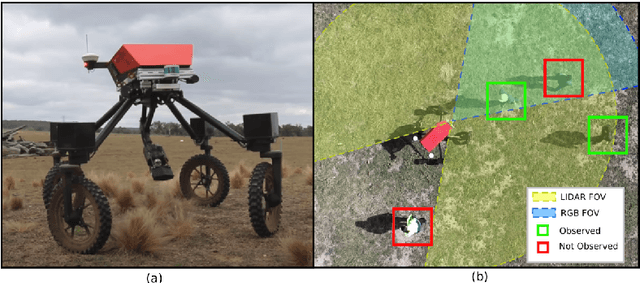
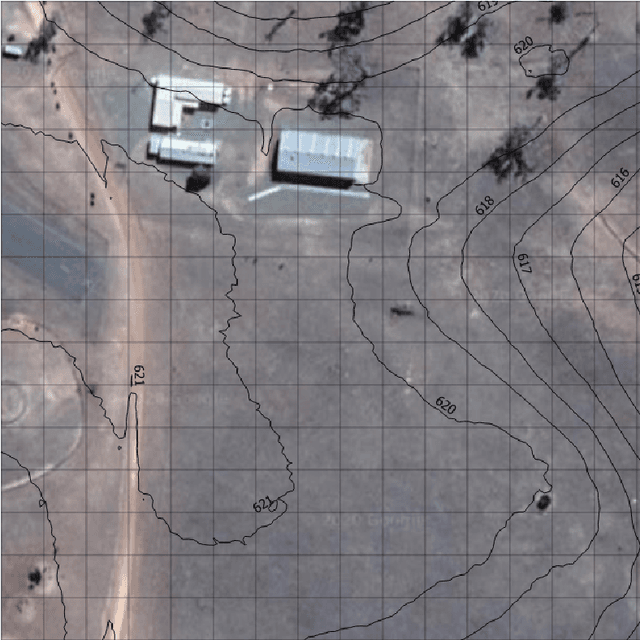
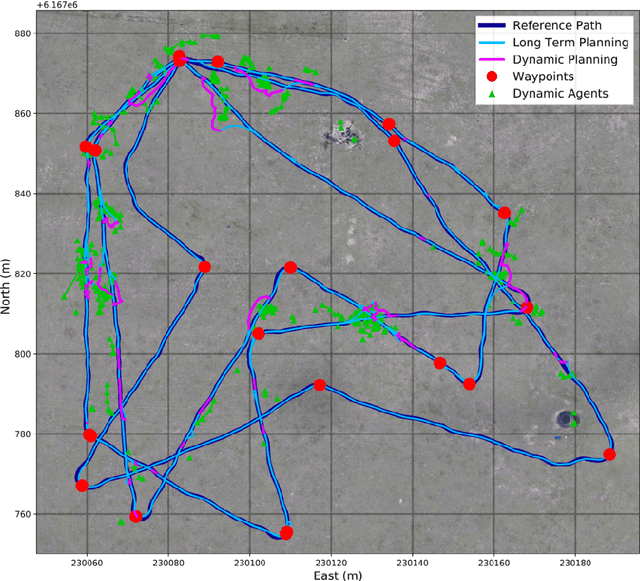
Abstract:For mobile robots to be effectively applied to real world unstructured environments -- such as large scale farming -- they require the ability to generate adaptive plans that account both for limited onboard resources, and the presence of dynamic changes, including nearby moving individuals. This work provides a real world empirical evaluation of our proposed hierarchical framework for long-term autonomy of field robots, conducted on University of Sydney's Swagbot agricultural robot platform. We demonstrate the ability of the framework to navigate an unstructured and dynamic environment in an effective manner, validating its use for long-term deployment in large scale farming, for tasks such as autonomous weeding in the presence of moving individuals.
Toolbox Spotter: A Computer Vision System for Real World Situational Awareness in Heavy Industries
May 23, 2021



Abstract:The majority of fatalities and traumatic injuries in heavy industries involve mobile plant and vehicles, often resulting from a lapse of attention or communication. Existing approaches to hazard identification include the use of human spotters, passive reversing cameras, non-differentiating proximity sensors and tag based systems. These approaches either suffer from problems of worker attention or require the use of additional devices on all workers and obstacles. Whilst computer vision detection systems have previously been deployed in structured applications such as manufacturing and on-road vehicles, there does not yet exist a robust and portable solution for use in unstructured environments like construction that effectively communicates risks to relevant workers. To address these limitations, our solution, the Toolbox Spotter (TBS), acts to improve worker safety and reduce preventable incidents by employing an embedded robotic perception and distributed HMI alert system to augment both detection and communication of hazards in safety critical environments. In this paper we outline the TBS safety system and evaluate its performance based on data from real world implementations, demonstrating the suitability of the Toolbox Spotter for applications in heavy industries.
Resource and Response Aware Path Planning for Long-term Autonomy of Ground Robots in Agriculture
May 22, 2021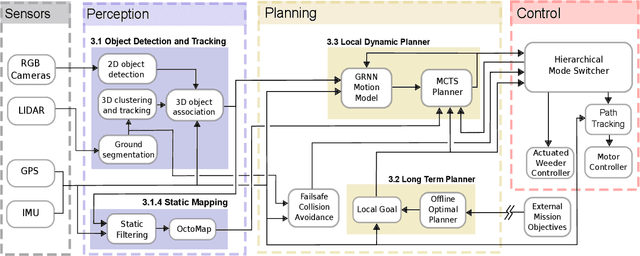

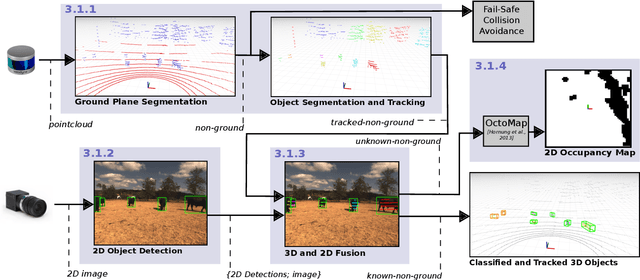
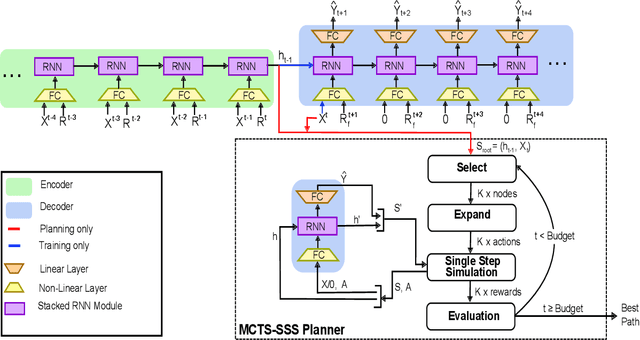
Abstract:Achieving long-term autonomy for mobile robots operating in real-world unstructured environments such as farms remains a significant challenge. This is made increasingly complex in the presence of moving humans or livestock. These environments require a robot to be adaptive in its immediate plans, accounting for the state of nearby individuals and the response that they might have to the robot's actions. Additionally, in order to achieve longer-term goals, consideration of the limited on-board resources available to the robot is required, especially for extended missions such as weeding an agricultural field. To achieve efficient long-term autonomy, it is thus crucial to understand the impact that online dynamic updates to an energy efficient offline plan might have on resource usage whilst navigating through crowds or herds. To address these challenges, a hierarchical planning framework is proposed, integrating an online local dynamic path planner with an offline longer-term objective-based planner. This framework acts to achieve long-term autonomy through awareness of both dynamic responses of individuals to a robot's motion and the limited resources available. This paper details the hierarchical approach and its integration on a robotic platform, including a comprehensive description of the planning framework and associated perception modules. The approach is evaluated in real-world trials on farms, requiring both consideration of limited battery capacity and the presence of nearby moving individuals. These trials additionally demonstrate the ability of the framework to adapt resource use through variation of the local dynamic planner, allowing adaptive behaviour in changing environments. A summary video is available at https://youtu.be/DGVTrYwJ304.
Attentional-GCNN: Adaptive Pedestrian Trajectory Prediction towards Generic Autonomous Vehicle Use Cases
Nov 23, 2020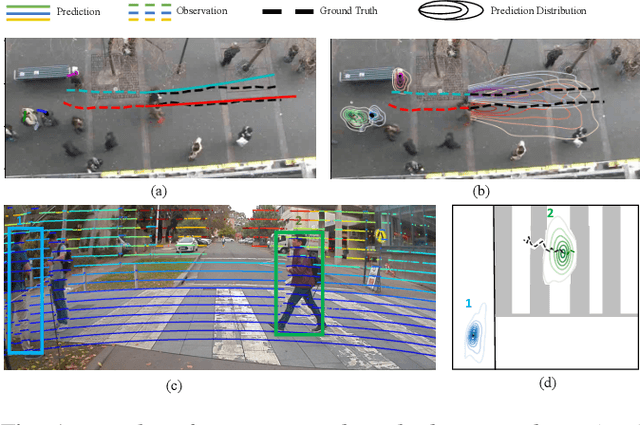


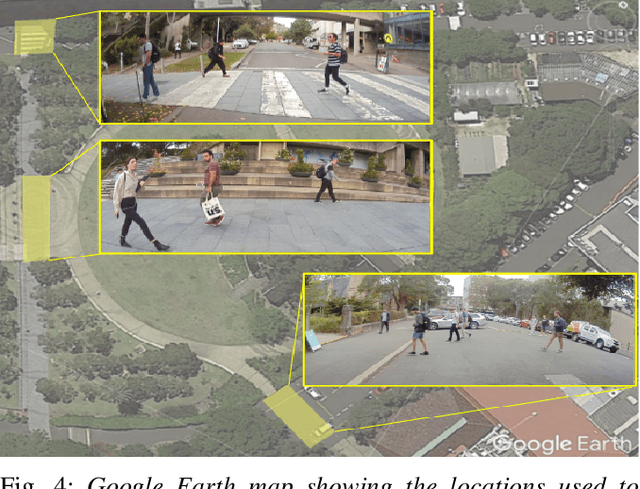
Abstract:Autonomous vehicle navigation in shared pedestrian environments requires the ability to predict future crowd motion both accurately and with minimal delay. Understanding the uncertainty of the prediction is also crucial. Most existing approaches however can only estimate uncertainty through repeated sampling of generative models. Additionally, most current predictive models are trained on datasets that assume complete observability of the crowd using an aerial view. These are generally not representative of real-world usage from a vehicle perspective, and can lead to the underestimation of uncertainty bounds when the on-board sensors are occluded. Inspired by prior work in motion prediction using spatio-temporal graphs, we propose a novel Graph Convolutional Neural Network (GCNN)-based approach, Attentional-GCNN, which aggregates information of implicit interaction between pedestrians in a crowd by assigning attention weight in edges of the graph. Our model can be trained to either output a probabilistic distribution or faster deterministic prediction, demonstrating applicability to autonomous vehicle use cases where either speed or accuracy with uncertainty bounds are required. To further improve the training of predictive models, we propose an automatically labelled pedestrian dataset collected from an intelligent vehicle platform representative of real-world use. Through experiments on a number of datasets, we show our proposed method achieves an improvement over the state of art by 10% Average Displacement Error (ADE) and 12% Final Displacement Error (FDE) with fast inference speeds.
Probabilistic Crowd GAN: Multimodal Pedestrian Trajectory Prediction using a Graph Vehicle-Pedestrian Attention Network
Jul 12, 2020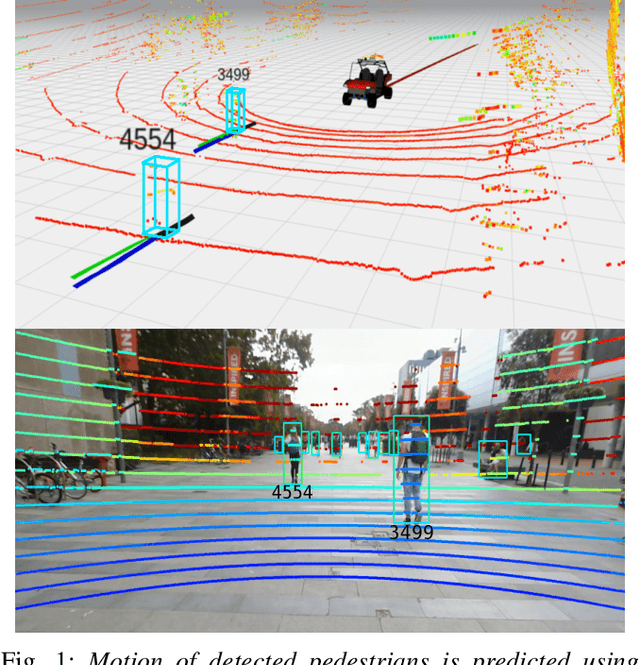


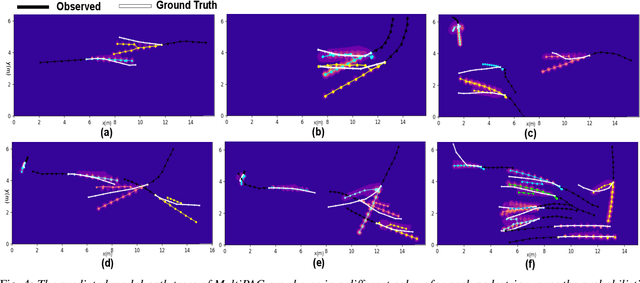
Abstract:Understanding and predicting the intention of pedestrians is essential to enable autonomous vehicles and mobile robots to navigate crowds. This problem becomes increasingly complex when we consider the uncertainty and multimodality of pedestrian motion, as well as the implicit interactions between members of a crowd, including any response to a vehicle. Our approach, Probabilistic Crowd GAN, extends recent work in trajectory prediction, combining Recurrent Neural Networks (RNNs) with Mixture Density Networks (MDNs) to output probabilistic multimodal predictions, from which likely modal paths are found and used for adversarial training. We also propose the use of Graph Vehicle-Pedestrian Attention Network (GVAT), which models social interactions and allows input of a shared vehicle feature, showing that inclusion of this module leads to improved trajectory prediction both with and without the presence of a vehicle. Through evaluation on various datasets, we demonstrate improvements on the existing state of the art methods for trajectory prediction and illustrate how the true multimodal and uncertain nature of crowd interactions can be directly modelled.
A Hierarchical Framework for Long-term and Robust Deployment of Field Ground Robots in Large-Scale Farming
Jun 24, 2020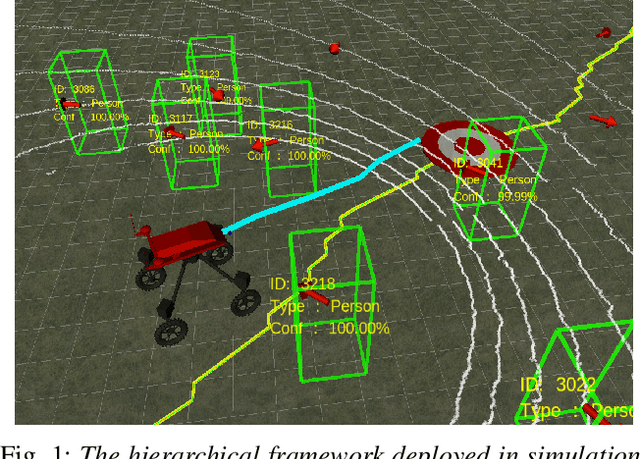

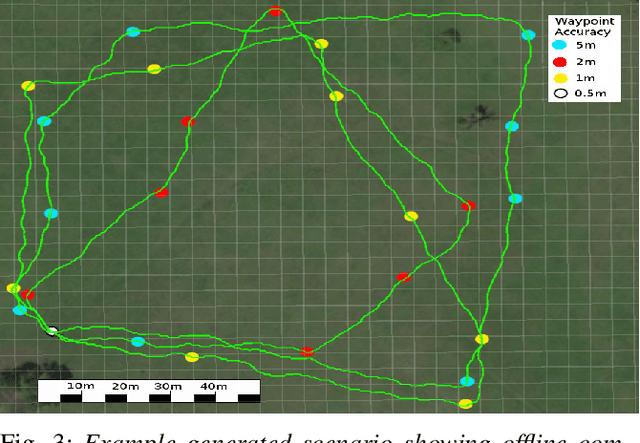
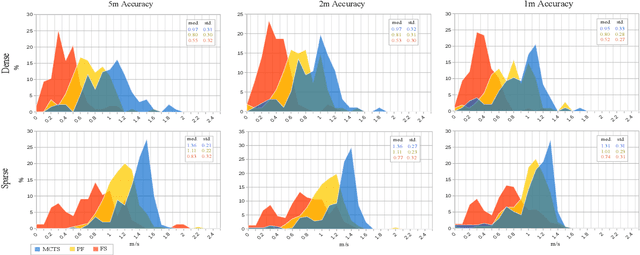
Abstract:Achieving long term autonomy of robots operating in dynamic environments such as farms remains a significant challenge. Arguably, the most demanding factors to achieve this are the on-board resource constraints such as energy, planning in the presence of moving individuals such as livestock and people, and handling unknown and undulating terrain. These considerations require a robot to be adaptive in its immediate actions in order to successfully achieve long-term, resource-efficient and robust autonomy. To achieve this, we propose a hierarchical framework that integrates a local dynamic path planner with a longer term objective based planner and advanced motion control methods, whilst taking into consideration the dynamic responses of moving individuals within the environment. The framework is motivated by and synthesizes our recent work on energy aware mission planning, path planning in dynamic environments, and receding horizon motion control. In this paper we detail the proposed framework and outline its integration on a robotic platform. We evaluate the strategy in extensive simulated trials, traversing between objective waypoints to complete tasks such as soil sampling, weeding and recharging across a dynamic environment, demonstrating its capability to robustly adapt long term mission plans in the presence of moving individuals and obstacles for real world applications such as large scale farming.
Path Planning in Dynamic Environments using Generative RNNs and Monte Carlo Tree Search
Jan 30, 2020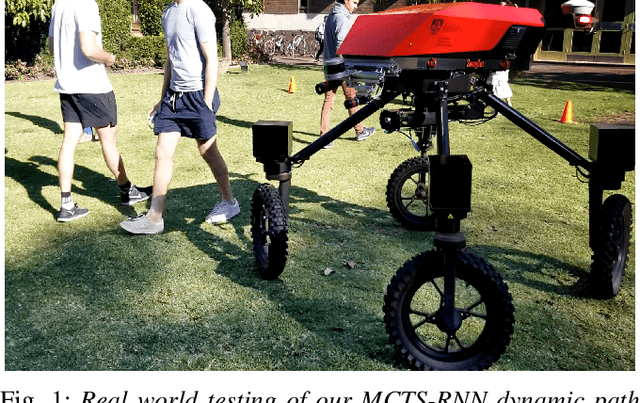
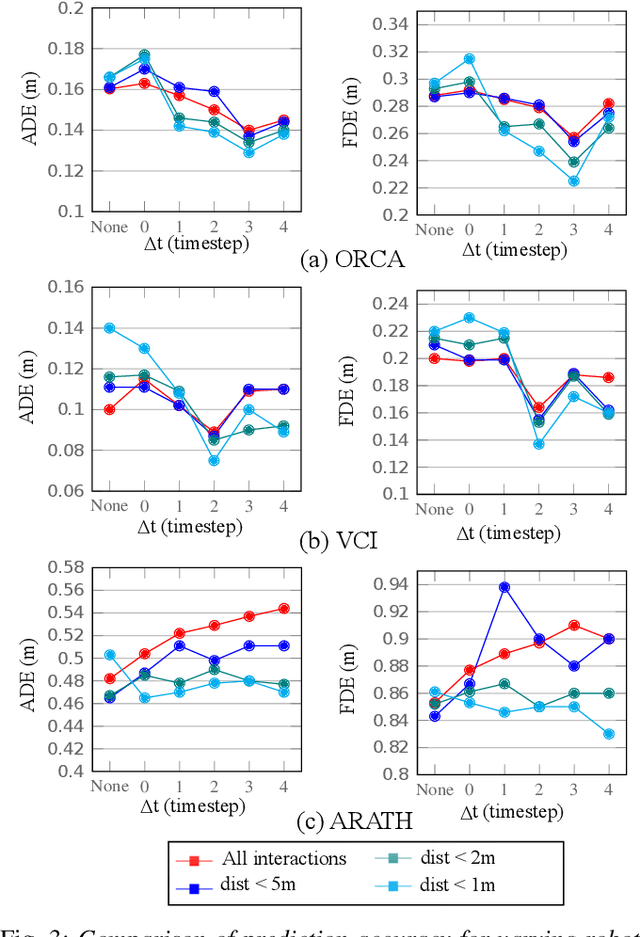
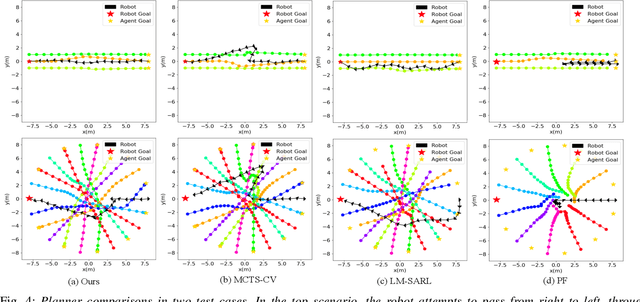
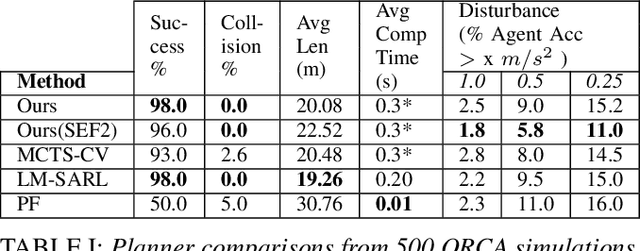
Abstract:State of the art methods for robotic path planning in dynamic environments, such as crowds or traffic, rely on hand crafted motion models for agents. These models often do not reflect interactions of agents in real world scenarios. To overcome this limitation, this paper proposes an integrated path planning framework using generative Recurrent Neural Networks within a Monte Carlo Tree Search (MCTS). This approach uses a learnt model of social response to predict crowd dynamics during planning across the action space. This extends our recent work using generative RNNs to learn the relationship between planned robotic actions and the likely response of a crowd. We show that the proposed framework can considerably improve motion prediction accuracy during interactions, allowing more effective path planning. The performance of our method is compared in simulation with existing methods for collision avoidance in a crowd of pedestrians, demonstrating the ability to control future states of nearby individuals. We also conduct preliminary real world tests to validate the effectiveness of our method.
Predicting Responses to a Robot's Future Motion using Generative Recurrent Neural Networks
Sep 30, 2019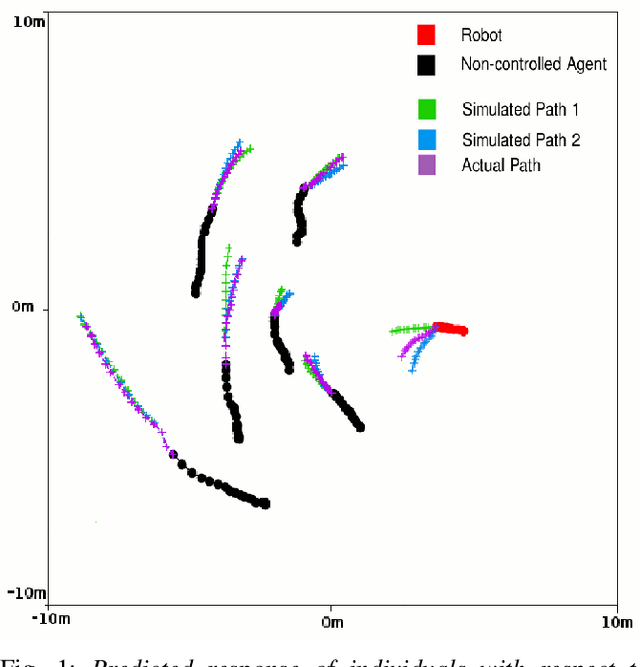

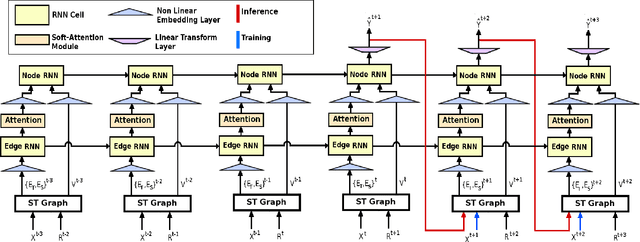
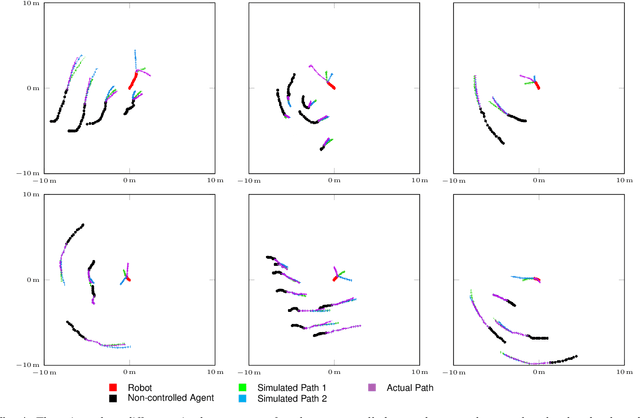
Abstract:Robotic navigation through crowds or herds requires the ability to both predict the future motion of nearby individuals and understand how these predictions might change in response to a robot's future action. State of the art trajectory prediction models using Recurrent Neural Networks (RNNs) do not currently account for a planned future action of a robot, and so cannot predict how an individual will move in response to a robot's planned path. We propose an approach that adapts RNNs to use a robot's next planned action as an input alongside the current position of nearby individuals. This allows the model to learn the response of individuals with regards to a robot's motion from real world observations. By linking a robot's actions to the response of those around it in training, we show that we are able to not only improve prediction accuracy in close range interactions, but also to predict the likely response of surrounding individuals to simulated actions. This allows the use of the model to simulate state transitions, without requiring any assumptions on agent interaction. We apply this model to varied datasets, including crowds of pedestrians interacting with vehicles and bicycles, and livestock interacting with a robotic vehicle.
 Add to Chrome
Add to Chrome Add to Firefox
Add to Firefox Add to Edge
Add to Edge